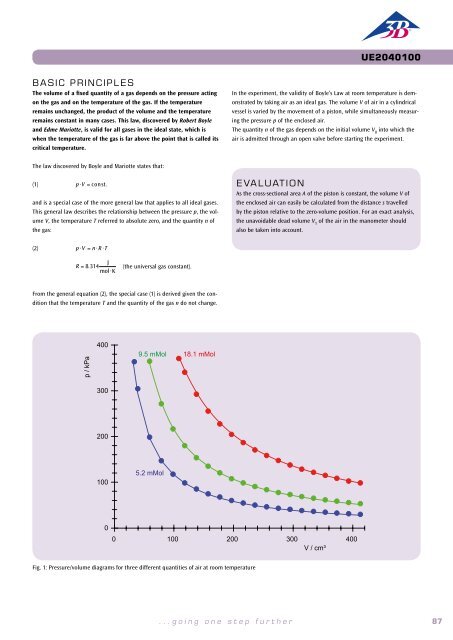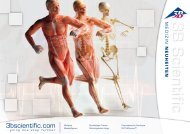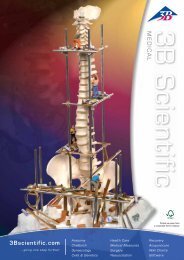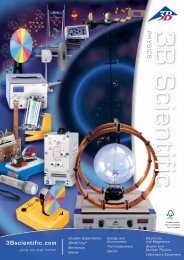3B Scientific - Physics & Engineering Experiments
3B Scientific - Physics & Engineering Experiments
3B Scientific - Physics & Engineering Experiments
You also want an ePaper? Increase the reach of your titles
YUMPU automatically turns print PDFs into web optimized ePapers that Google loves.
UE2040200<br />
Thermodynamics/Gas Laws<br />
Adiabatic index of air<br />
UE2040200<br />
EXPERIMENT<br />
PROCEDURE<br />
• Measure the period of oscillation of the<br />
aluminium piston.<br />
• Determine the equilibrium pressure<br />
within the enclosed volume of air.<br />
• Determine the adiabatic index of air<br />
and compare your result with the value<br />
quoted in literature.<br />
2<br />
Required Apparatus<br />
OBJECTIVE<br />
Determine the adiabatic index C p<br />
/ C V<br />
for<br />
air using Rüchardt’s method<br />
SUMMARY<br />
In this experiment an aluminium piston inside<br />
a precision-manufactured glass tube extending<br />
vertically from on top of a glass vessel undergoes<br />
simple harmonic motion on top of the cushion<br />
formed by the volume of air trapped inside the<br />
tube. From the period of oscillation of the piston,<br />
it is possible to calculate the adiabatic index.<br />
Quantity Description Number<br />
1 Mariotte Flask 1002894<br />
1 Oscillation Tube 1002895<br />
1 Mechanical Stopwatch, 15 min 1003369<br />
1 Vacuum Hand Pump 1012856<br />
Additionally recommended:<br />
1 Aneroid Barometer F 1010232<br />
1 Callipers, 150 mm 1002601<br />
1 Electronic Scale 200 g 1003433<br />
BASIC PRINCIPLES<br />
In a classic experiment designed by Rüchardt, it is possible to determine<br />
the adiabatic index for air from the vertical oscillations of a piston resting<br />
on a cushion of air inside a glass tube of constant cross-sectional<br />
area. The piston itself fits snugly and forms an air-tight seal. Disturbing<br />
the piston from its equilibrium position causes the air inside the tube<br />
to become expanded or compressed, causing the pressure inside to rise<br />
above or below atmospheric pressure, the effect of which is to restore<br />
the piston to its equilibrium position. The restoring force is proportional<br />
to the deviation from the equilibrium position, meaning that the<br />
piston exhibits simple harmonic oscillation.<br />
consists of diatomic molecules with 5 degrees of freedom for the absorp-<br />
1<br />
γ ⋅V p ⋅ m A 2 γ =<br />
⎛ 2π<br />
⎝<br />
⎜<br />
T<br />
T = 2π<br />
its rest state:<br />
p = p 0<br />
+ m⋅ g<br />
A<br />
The expected result is therefore<br />
tion of heat energy.<br />
p ⋅V γ = const.<br />
γ = C p<br />
C V<br />
Δs<br />
Since there is no exchange of heat with the surroundings, the oscillations<br />
are associated with adiabatic changes of state. The following equation<br />
describes the relationship between the pressure p and the volume V of the<br />
enclosed air:<br />
(1)<br />
The adiabatic index γ is the ratio between the specific heat capacity at constant<br />
pressure C p<br />
and constant volume C V<br />
:<br />
(2)<br />
From equation (1), the following relationship can be derived for changes in<br />
pressure and volume Δp and ΔV<br />
(3)<br />
By substituting the internal crosssectional area A of the tube, the restoring<br />
force ΔF can be calculated from the change in pressure. Similarly the deflection<br />
of the piston from its equilibrium position can be determined from the<br />
change in volume.<br />
Therefore, the following applies:<br />
(4)<br />
This leads to the equation of motion for the oscillating piston.<br />
(5)<br />
Δp + γ ⋅ p ⋅ΔV = 0.<br />
V<br />
ΔF = −γ ⋅ p V ⋅ A2 ⋅Δs = 0.<br />
m⋅ d2 Δs<br />
dt 2 + γ ⋅ p V ⋅ A2 ⋅Δs = 0<br />
m = Mass of piston<br />
Solutions to this classical equation of motion for simple harmonic oscillators<br />
are oscillations with the following period:<br />
(6) ,<br />
From this, the adiabatic index can be calculated as long as all the other<br />
variables are known.<br />
In this experiment, a precision-made glass tube of small cross section A is<br />
set up vertically in a hole through the stopper for a glass vessel of large<br />
volume V and a matching aluminium piston of known mass m is allowed to<br />
slide up and down inside the tube. The aluminium piston exhibits simple<br />
harmonic motion atop the air cushion formed by the enclosed volume. It<br />
is possible to calculate the adiabatic index from the period of oscillation of<br />
the piston.<br />
EVALUATION<br />
The equilibrium volume V corresponds to the volume of the gas vessel,<br />
since that of the tube is small enough to be disregarded.<br />
The equilibrium pressure p is obtained from the external air pressure p 0<br />
and the pressure exerted by the aluminium piston on the enclosed air in<br />
, where g = acceleration due to gravity<br />
γ = 7 , since air predominantly<br />
5 = 1.4<br />
p, V<br />
Fig. 1: Schematic of experiment set-up<br />
2<br />
⎞<br />
⎠<br />
⎟ ⋅ m A ⋅V 2 p<br />
m<br />
A<br />
p 0<br />
88 <strong>3B</strong> <strong>Scientific</strong>® <strong>Experiments</strong> ...going one step further 89















